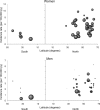Temporal trends in the incidence of multiple sclerosis: a systematic review
- PMID: 18606967
- PMCID: PMC4109189
- DOI: 10.1212/01.wnl.0000316802.35974.34
Temporal trends in the incidence of multiple sclerosis: a systematic review
Abstract
Background: Multiple sclerosis (MS) has been traditionally considered to be more frequent in women and in regions more distant from the equator. However, recent reports suggest that the latitude gradient could be disappearing and that the female-to-male ratio among patients with MS has increased in the last decades. We have conducted a systematic review of incidence studies of MS to assess the overall incidence of MS and explore possible changes in the latitude gradient and the female-to-male ratio over time.
Methods: Systematic review of incidence studies of MS published in Medline between 1966 and February 2007. Age- and sex-specific incidence rates were collected from eligible publications. We computed age-adjusted rates using the world population as standard, and assessed differences in rates according to latitude and period of case ascertainment. Additionally, we evaluated the association between period of case ascertainment and the female-to-male ratio.
Results: The overall incidence rate of MS was 3.6 cases per 100,000 person-years (95% CI 3.0, 4.2) in women and 2.0 (95% CI 1.5, 2.4) in men. Higher latitude was associated with higher MS incidence, though this latitude gradient was attenuated after 1980, apparently due to increased incidence of MS in lower latitudes. The female-to-male ratio in MS incidence increased over time, from an estimated 1.4 in 1955 to 2.3 in 2000.
Conclusion: The latitude gradient present in older incidence studies of multiple sclerosis (MS) is decreasing. The female-to-male MS ratio has increased in the last five decades.
Figures


References
-
- Hirtz D, Thurman DJ, Gwinn-Hardy K, Mohamed M, Chaudhuri AR, Zalutsky R. How common are the “common” neurologic disorders? Neurology 2007;68:326–337. - PubMed
-
- Acheson ED, Bachrach CA, Wright FM. Some comments on the relationship of the distribution of multiple sclerosis to latitude, solar radiation, and other variables. Acta Psychiatr Scand Suppl 1960;35:132–147. - PubMed
-
- Kurtzke JF, Beebe GW, Norman JE. Epidemiology of multiple sclerosis in US veterans: 1. Race, sex, and geographic distribution. Neurology 1979;29:1228–1235. - PubMed
-
- Noseworthy JH, Lucchinetti C, Rodriguez M, Weinshenker BG. Multiple sclerosis. N Engl J Med 2000;343:938–952. - PubMed
Publication types
MeSH terms
Grants and funding
LinkOut - more resources
Full Text Sources
Other Literature Sources
Medical
